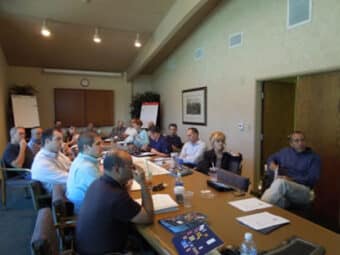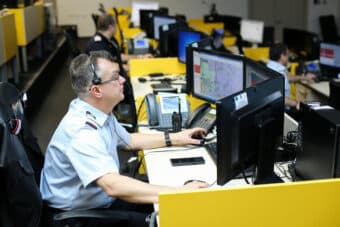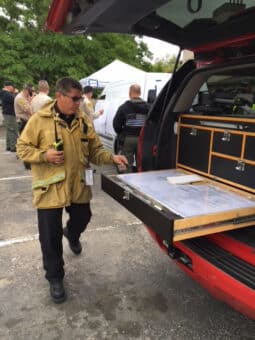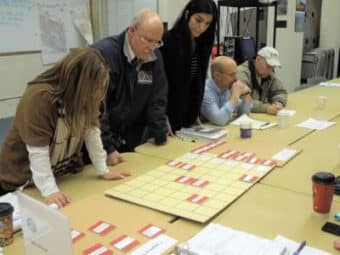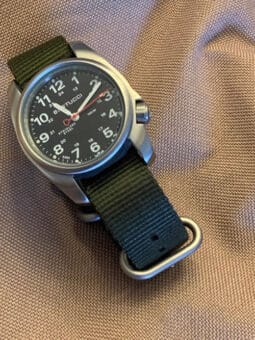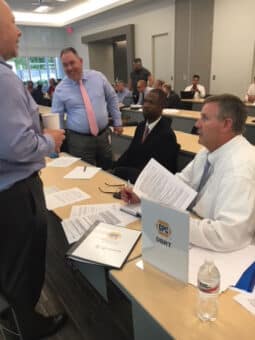Preparing for the Active Shooter Scenario: Designing and facilitating tabletop exercises
by Roger Mason PhD
Introduction
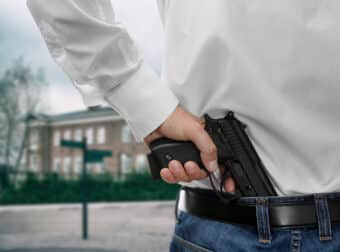 Our society is dealing with a dramatic surge in violent attacks from persons known as “active shooters.” As a result, there is a fresh interest in preparedness and preparation to protect schools, public spaces, houses of worship, businesses, and any other places where groups of people can be found. The military and public safety agencies have a long history of employing exercises and active decision-making simulations to train and prepare for infrequent but high-risk events.
Our society is dealing with a dramatic surge in violent attacks from persons known as “active shooters.” As a result, there is a fresh interest in preparedness and preparation to protect schools, public spaces, houses of worship, businesses, and any other places where groups of people can be found. The military and public safety agencies have a long history of employing exercises and active decision-making simulations to train and prepare for infrequent but high-risk events.
(Note: In this article I also use the term “mass attack event.” Most people are only familiar with the term “active shooter.” The problem of mass attacks is much greater than just the use of firearms. In the past year subjects have driven cars through crowds, and persons with knives have attacked victims in various locations from hospital emergency rooms to airline baggage terminals.)
Techniques like tabletop exercises and wargaming are useful for training and planning for mass attacks. Organizations faced with these threats want practical methods that will help them prepare and respond. This article introduces the use of a simulation in the form of a tabletop. This article will explain how tabletops work, modeling focused violence events, how to organize your tabletop, developing a scenario, simple design tips, and facilitating a tabletop exercise.
A tabletop exercise does not have to be complicated to be valuable. Simple games can produce incredible complexity. Chess is played using 32 pieces on a black and white grid of 64 squares. After three turns 8,902 playing positions are possible. A tabletop’s complexity does not come from the number of scenario details but the interactions between the players and the situations that emerge.
 How Do Tabletop Exercises Work?
How Do Tabletop Exercises Work?
FEMA defines tabletop exercises as “discussion-based sessions in which key personnel meet in an informal setting to discuss their roles during an emergency and their responses to a hypothetical, simulated emergency.” The basic tabletop exercise is designed in a seminar format. A scenario is provided to the players which supplies the back story which contains various problems. During the exercise, the players discuss how to solve the problems and actions they would take.
Tabletop exercises are typically employed for planning or training. Tabletops can test or help to develop a plan or a specific course of action. They are also useful in training to use a new plan or evaluating a team’s ability to employ their current plan. In addition, tabletop exercises can be used to refresh perishable skills. Finally, a tabletop exercise is an excellent tool for team development.
Is There More Than One Type of Tabletop Exercise?
Tabletop exercises can be developed in three forms. The first is the simple seminar format. It may be facilitated as a round table discussion where the participants discuss problems and offer solutions. Players are often assigned roles that represent real-world decision-makers or organizations.
In a simple active shooter tabletop involving five participants the player assignments might be police, fire, emergency medical services, a school principal, and the school district superintendent. In a simple tabletop, problem-solving is direct and usually somewhat limited. As the complexity of the exercise deepens there may be need for more nuanced skills such as operational negotiating and prioritizing preferences.
The second type of tabletop is a focused tabletop where more and more real-world connections are introduced. Taking the above example, the five player assignments might correspond to specific organizations or situations. Real-world situations may be used along with some of the strengths and limitations of the real organizations.
A focused tabletop may include tools found in active learning environments. Active learning encourages the use of real-world tools in a constructivist format. Students learn from each other, solve problems, and make decisions. More advanced tabletops use maps and playing pieces to represent real-world units.
This has several benefits. The map and playing pieces connect the players. They become familiar with the spatial relationships and challenges. They become acquainted with the problems and competing preferences of their fellow players. The map becomes a useful representation of the entire incident and a focal point for active problem-solving.
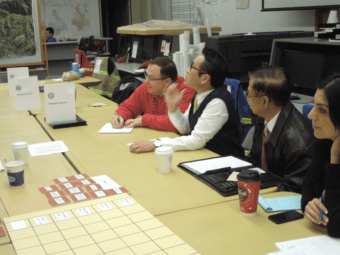
This type of tabletop has three parallel operations (attacker neutralization, rescue and evacuation, and triage of victims). Unlike a task or discipline specific tabletop this exercise will emphasize coordinating simultaneous operations. A useful technique is to break the disciplines into three groups and offer problem-solving that requires cooperation.
Modeling Mass Attack Events
The first step in designing a tabletop exercise is understanding what type of event you are trying to simulate. The Department of Homeland Security has identified four types of mass attack events:
- The use of firearms to cause mass casualties (active shooter)
- The use of explosive devices to cause mass casualties
- The use of a vehicle to cause mass casualties
- Other methods may include knives, drones, fire, or various weapons.
Building a Model
People correctly described a mass attack event as chaotic. However, merely stating the obvious does not offer a foundation to analyze it or duplicate it. To produce a workable model of a chaotic event like a mass attack it is necessary to understand the conditions it produces and the overlapping efforts to mitigate the effects.
Why does a mass attack cause panic and chaos? The Oxford American Dictionary defines chaos as “complete confusion and disorder.” Confusion results when people are disrupted from their normal momentary expectations and blocked from familiar patterns of behavior. These expectations and behavior patterns form what people perceive as normal and safe.
When this is suddenly disrupted by extreme violence the average person is terrorized. The speed at which this disruption occurs adds to feelings of panic. Compounding the chaos are new environmental factors like the first responders attempting to neutralize the threat or rescue the victims. So how much of this should be included in your tabletop?
A tabletop exercise is not a complete model of a mass attack event. For your model you can accept related conditions as part of the back story of the scenario. There has been a shooting and people are fleeing the building. The suspect must be located and neutralized, and the victims must be cared for. For your first tabletop, it will be best to select one element for your scenario. As you gain experience you can add others.
Elements of a Mass Attack
A mass attack tabletop exercise can explore the primary incident elements. They are the initial response, rescue/evacuation, mass casualty management, and incident command. Each of these topics can provide a challenging scenario.
The initial response begins with reports of an attack. These are often prompted by 911 calls. In some public events public safety personnel may already be on scene conducting traffic and crowd management. The first step is to isolate the area to prevent the attacker from becoming mobile allowing them to escape or continue their attack elsewhere.
The next step is identifying the attacker’s location and attempting to contact and neutralize them. If the subject is in a building this may include forced entry and assault operations. For persons trapped in a building there may be organized procedures for sheltering in place. This exercise scenario should focus on the first responders and any procedures available to the persons at the scene of the attack.
Rescue and Evacuation
During some mass attacks, public safety may conduct rescue and evacuation concurrently with the efforts to neutralize the attacker. Exit/evacuation corridors are established and secured. As various individuals or groups are rescued, they are directed into one of these exit corridors. There may be persons who are injured. This will require coordination with the fire department. The fire department will manage the rescue of the injured while law enforcement protects them from the attacker.
The third aspect of a mass attack response is the management of casualties. This falls into two tasks, conducting a triage evaluation of the victims and their transportation to a hospital. Triage aims to maximize the number of survivors by prioritizing care to victims that can be treated and transported. A tabletop exercise of a mass casualty event should include the medical response and treatment organization, scene organization including a physical perimeter, and traffic management of emergency vehicles.
Incident Command
The fourth element of a mass attack event is employing incident command methods to direct the response. FEMA defines it as “the combination of facilities, equipment, personnel, procedures, and communications operating within a common organizational structure, designed to aid in the management of resources during incidents.” This type of scenario will focus on coordinating the various responders and managing resources for the incident from the initial response to securing the scene.
Setting the Game
Setting the game refers to the tabletop objectives, the scenario level, the audience, and the doctrine or procedures you need in your exercise.
Objective
The first step is determining the objective of the tabletop. Are you introducing new decision-makers to their roles or evaluating a course of action? There are four considerations in setting a game and the objective is critical to each one. By clearly establishing the objective of the tabletop you improve the chances the exercise will be successful.
Domain
By domain we mean how will be game be employed. Tabletop exercises can be divided into four functional domains: training, developing plans, testing existing plans, and evaluation. Training can be used to introduce new information and develop fresh skills or rehearse mission critical capabilities. Tabletop exercises work well to test or develop plans. They can also be employed as an active learning tool to test requisite skills and knowledge.
Scenario
In the book The Craft of Wargaming by Jeff Appleget, Robert Burks, and Fred Cameron the authors state, “The scenario sets the scene or narrative for players and establishes the world in which they will make decisions.” The scenario provides the backstory for the tabletop. This backstory must be closely related to your objectives. For example, if your objective is to test your shelter in place plan the scenario should not focus on evacuations.
The scenario must provide the players with enough information so they understand the environment they will operate in, their relationships to the other players, and their objectives. The environment is the real-world situation you are modeling (ex: a school, a shopping mall, a post office.) The term relationships refer to how the specific player assignments interact with one another. For example, will one of the tabletop players supervise the other players or are the players peers? Finally, the players need to know what their objectives are. Is the objective reunifying students with their parents, evacuating a public space, or sheltering in place?
Audience
When organizing a tabletop, it is essential to know who the audience will be. By audience, I mean the people who will participate in the exercise, whether they are knowledgeable with their emergency assignments, and familiar with tabletop exercises.
Critical Success factors for Tabletop Exercise
Three critical success factors will help ensure a successful tabletop.
Your tabletop exercise must be accessible by the players. When the exercise begins, they need to quickly understand the objective of the exercise, the scenario, their role, and how the exercise will be conducted. In addition, the exercise should employ terms and operational methods they are familiar with. This type of familiarity will help the players to engage with the exercise. The exception is a training tabletop where the players are introduced to new concepts or procedures.
Emphasize Solutions Over Failure
A tabletop exercise should emphasize team problem-solving. In a real-world critical incident, decision-makers of various disciplines must work together. For example. When responding to a mass attack some of the responders will include law enforcement, fire/rescue, and incident command. These disciplines are trained to work together to solve problems. Your tabletop should encourage this.
Another critical success factor is avoiding the no-win scenario. A no-win scenario contains problems that are impossible to solve within the parameters of the exercise. If the scenario includes problems that exceed the participant’s abilities or their simulated capabilities, the result will be player dis-engagement. This does not mean that complicated problems should be avoided. A better approach is to include challenges but ensure there are avenues for a solution.
Maintaining Exercise Focus
By setting the game you establish the domain and your objectives. It will be the responsibility of the facilitator to keep the exercise on track. Some common issues that can arise during a tabletop include rabbit holes, scenario drift, and kidnapping.
A rabbit hole occurs when the focal point of the scenario is lost in a never-ending series of seemingly related but non-essential topics. Scenario drift occurs when the focus on the objective is lost and the issues designed as part of the scenario are spontaneously replaced. Kidnapping occurs when one of the participants wants to redirect the focus of the exercise to their discipline or perceived expertise. All three of these tendencies reduce the opportunity for meaningful problem-solving.
 Time and Tabletops
Time and Tabletops
There are two aspects related to time when conducting tabletops. They are the practical aspects of time during the exercise and the use of time in your scenario.
Time and the Exercise
Large organizations like the US Department of Defense have the luxury of time where exercises may run for days or weeks. For most local governments or organizations this is not the case. The amount of time available is often very limited. The limitation of available exercise time is directly related to the objective of the exercise. Only plan as much as you can accomplish, including time for discussions, problem-solving, and the after-action debrief.
Time in the Scenario
Persons designing their first tabletops are often unsure how to incorporate time into the scenario. Attempting to simulate real time on a one-to-one basis is often impractical. There are several techniques that can be employed.
Continuous Time
The facilitator provides the scenario and a start point for the players. From this point the players make continuous decisions and actions. The facilitator may temporarily hold play to answer a question, adjudicate an action, or move the exercise ahead in scenario time.
Discrete Packets of Time
In this technique the facilitator provides the information and context for the time in the scenario. They provide the information needed by the players. The facilitator can move the exercise to critical points where problems can be addressed. Here is an example.
“We are in our first decision phase of the exercise. Five minutes ago the police department received numerous 911 calls of an active shooter at the local high school. Each of the exercise teams will develop their initial plan of action.”
At the end of the decision phase each team provides the actions they would have taken. The facilitator can continue the scenario from that point or move forward to a new point in time. “We are now in decision phase number two. It has been thirty minutes of time since the initial 911 calls. Based on your initial plans a perimeter has been established around the school, an initial entry has started searching for the suspect, persons self-evacuating are being moved to a nearby parking structure, and a staging and triage area has been established for the fire department/EMS teams. You have ten minutes to develop you next actions.”
Focused Point in Time
Using a focused point in time is useful when you want to direct the exercise to a single point. This must be set up by context and scenario background. Here is an example.
“For the past hour your team has been managing an active shooter incident at the local high school. After setting a perimeter and making entry the search of the school has been continuing. The triage area is processing the shooting victims and evacuees are being moved to a secure location. Our team observes smoke coming from the school library area which has not been secured.”
In this scenario, time has move forward to a specific point where action must be taken. The exercise team has information that an unsecured section of the school has caught fire. The player decision-makers must focus on a specific critical issue.
The Role of the Facilitator
The facilitator is a critical component in a successful tabletop exercise. No matter how carefully the exercise has been designed it still requires a facilitator to manage the exercise and bring it to life. There are several factors facilitators should consider.
Know Your Audience
It is very useful to review who will be participating in the exercise. You should review their job titles. real-world responsibilities, and experience.
Being Ready
Everything you need for the exercise must be in place when the participants enter the room. This is not the time to start making photocopies of briefing materials. Many facilitators prepare an exercise summary that outlines the objective and describes how the exercise will be conducted. The summary is provided to participants prior to the day of the exercise. Being ready helps to set the proper tone for the tabletop.
Exercise Overview
The exercise should begin with a brief overview. It is helpful to review what will happen and what part the participants will play. This is the time to answer procedural questions and ensure everyone is ready to participate.
Adjudication
There are several methods for adjudicating the decision outcomes. The most straightforward approach is having the facilitator adjudicate the question. This can be problematic if the exercise contains a specific technical or procedural aspect the facilitator/adjudicator is not familiar with. If this factor is important to the exercise, you should employ a subject matter expert to support the facilitator. This person can assist with any complicated rulings. Remember the tabletop exercise is not a wargame where adjudication processes are critical.
Watching the Clock
One of the most important jobs of the facilitator is watching the clock. This means tracking the progress of the exercise to ensure the objectives are met within the allotted exercise time. If the exercise bogs down, employing techniques like moving ahead to a specific scenario focal point may be useful.
“Keeping it Real”
The facilitator must limit the player’s decisions and actions to conditions reflected in the real-world. Do not allow players to request resources that are not available or something immediately that typically takes time to procure. A good example are tactical or special weapons teams. Only a handful of the largest cities in the United States have this type of resource immediately available 24 hours a day. Everyone else employs a variety of mobilization and deployment processes that take time. Requesting a tactical team and having it staged at the front entrance of a hostage location are two different things. Keep players’ actions and decisions realistic.
A typical problem of tabletop exercises is indifferent engagement. Often times a handful of people make the decisions and take the actions while others just stand around. All the deliberative conversations are held by a handful of people. There is a simple technique to increase individual participation in the exercise. During the exercise overview announce that each team(s) will be asked to participate in the debrief by providing an explanation of their decisions and actions. Add that the facilitator will select the person(s) who will represent their team.
The Debrief
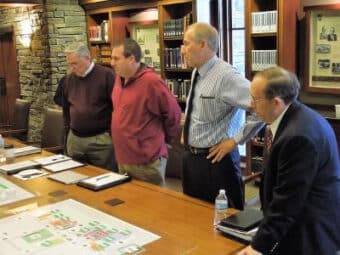
It is important the facilitator develop a series of questions prior to the exercise. This provides a framework for the debrief. The questions should be related to the exercise objectives. It is important to keep it positive especially if the team struggled during the exercise. This is accomplished by how you word the discussion questions. Do not ask “What went wrong?” A better approach is “What was your greatest challenge?” Another question is “What was your toughest decision?” or “What would you do differently?” This allows the players a fault free environment which improves the discussion flow.
Another technique is to employ the roundtable approach. Each player is asked a question. This ensures that everyone gets an opportunity to participate.
Summary
A tabletop exercise can be an excellent tool to preparing for an active shooter or mass attack event. They provide leaders and decision-makers the opportunity to experience a very unusual critical incident in a risk-free environment. Tabletops are relatively inexpensive to produce and can be run repeatedly once the design is complete. They are useful in analyzing specific issues related to the elements of a mass attack. There is an old saying about tabletops. “You can play it now or live it later.” A small investment in preparation, design, and training can make a critical difference during the real thing.

